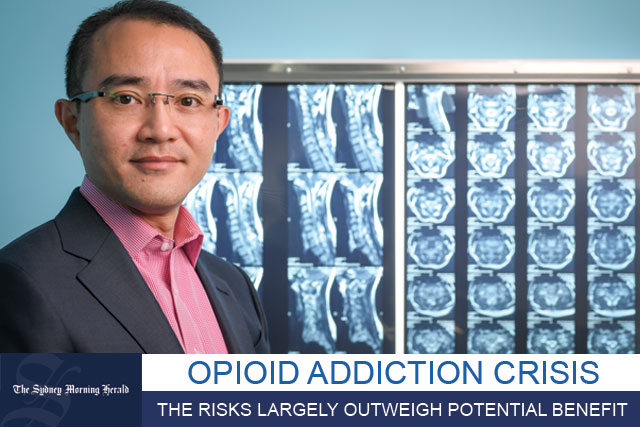
The Opioid Addiction Crisis in Australia
Dr. Wong campaigns against the over-prescription of opioid medication in the treatment of chronic pain, in particular in relation to back pain management.
The opioid epidemic in the US paints a grim picture for the outlook Australia faces if it continues down a dark path of opioid over-prescription. Between 1992 and 2012, opioid dispensing by doctors in Australia increased by 15%, according to Pain Australia.
A staggering 1.9 million Australian adults begin taking prescription opioids every year. Prescription opioids are prescribed as very strong pain medication, intended to help people with debilitating pain as a result of illness, disease and injury. However, recent general practice data shows that opioids were prescribed in 73% of cases where patients complained of general multi-site pain.
The main ingredient in such opioids being oxycodone, a chemical that is powerful, effective, and highly addictive. Addiction to an opioid has many detrimental outcomes, primarily an increased risk of overdose. Deaths involving opioids have nearly doubled in the last 10 years in Australia (1). Overdose from prescription medicines has already overtaken road deaths and illicit drug overdose as a cause of death in Australia.
Opioids and Pain Management
Chronic and prolonged pain is incredibly taxing on not only a person’s physical body, but the impact on their emotional, social and spiritual well-being can be far-reaching and is often overlooked when assessing pain treatment options. While opioids can provide some relief from such pain, the risk of addiction is extremely alarming and should be approached with caution. Unfortunately in many cases, patients simply aren’t offered alternative solutions or opioid medication is perceived as the “easy option”.
Dr. Wong experienced first-hand the toll chronic and severe pain can take on a patients mental and physical health, after being stabbed 14 times in a hospital foyer. This experience has led him to strongly advocate for chronic pain alternatives to opioids and proper referral for patients suffering chronic pain. Correct analyses and investigation of the pain is required to correctly determine the root cause of the pain rather than treating the symptom (pain).
‘‘…the investigation part is missing. People don’t want to find out the cause. They’re placed on strong pain medication for a long time and I think, in a good proportion of patients, that’s the wrong treatment.’’
What we can learn from the U.S. Opioid Crisis:
What began in the late 1990’s as a genuine pain-treatment option, was quickly exploited by pharmaceutical companies who strongly and persuasively encouraged doctors to prescribe opioids. This completely unethical behaviour, in an effort to generate revenue, led to one of the worst health epidemics in America’s modern history.
The implications of such a crisis have seen far reaching effects across the nation’s health; incredible increases in opioid misuse and related overdoses where 130 people die day per day from opioid overdose (2016-2017) (2), as well as the rising incidence of neonatal abstinence syndrome due to opioid use and misuse during pregnancy. The increase in injection drug use has also contributed to the spread of infectious diseases including HIV and hepatitis C.
The CDC (Centres for Disease Control and Prevention) places the total cost to the US economy at a staggering $78.5 billion per year, “including the costs of healthcare, lost productivity, addiction treatment, and criminal justice involvement”. The financial burden to the economy is so significant and far reaching that preventative and treatment measures in Australia should be of the highest importance.
Preventing an Opioid Epidemic in Australia
While Australia hasn’t been completely exempt from the devastating effects opioids can have on the population at large, Dr. Wong says there are a number of approaches we can take to prevent the issue from becoming an epidemic like we see in the U.S.
1. Better awareness & government support of alternatives to opioids for pain management
Pain is the number one reason people visit a GP and pain is the number one reason an opioid is prescribed. Often opioids are prescribed to patients without any other treatment options presented, yet opioids should never be the first-line of treatment offered to a patient with chronic pain. Dr Wong says he treats large numbers of patients who are in the dark about why they have long-term spinal pain and many have been taking opioids for months when he meets them.
Pain is widely misunderstood and often doctors are under-resourced or trained in how to treat pain in their patients. This is particularly a problem in rural and regional Australia where doctors have limited options for referral outside opioid prescription. And widely opioids are often viewed as the easiest and cheapest option in managing pain.
While GP’s need better training and education on pain management and treatment, more importantly they need greater referral options so they can refer patients on to properly-funded services such as pain management clinics, psychologists, physiotherapists. This way, patients can get specialized help to identify the root problem causing their pain and help them to manage their pain unique to their condition/issue.
2. Improving access to treatment and recovery services
Tolerance is the catalyst to addition. When your body becomes accustomed to a drug it develops a tolerance, overtime leading to a dependence, meaning you require a higher dose of the same drug to get the same result (high) you got before. This tolerance and the need to constantly feel the same or greater ‘high’ is often where we see overdose occur.
It is important to increase awareness of addiction signs, and both doctors and pharmacists play a key role here. Patients should always be made aware of indicators/signs of addiction so they can self-monitor while medicating but doctors/pharmacists should be acutely aware of preempting/addressing any potential warning signs with patients too.
Potential warning signs of opioid addiction:
– “Doctor Shopping”: patients switching healthcare providers or pharmacists in order to increase dosage due to tolerance and addiction.
– Misuse: using the drug in a way outside of the way it prescribed or intended. This includes altering the dosage application i.e. crushing and inhaling or injecting rather than taking as a pill
– Lack of control: dependancy on the drug and inability to stop taking the opioid even if you want to
Doctors and pharmacists need to be able to address the issue with the patient and refer the patient to properly-funded support options to help them treat the addiction such as an opioid treatment centre.
3. Better research & surveillance on opioid addiction
Research and data provides us with invaluable insights into the true situation of opioid use and addiction in Australia. Using this data we can identify key problem areas, root causes of problems leading to addiction and connections between medical opioid prescription and on-going drug addiction and use. This data influences decision making, government & private funding and treatment options available to patients so is imperative to solving the problem once and for all, and providing the population with better options for pain management.
Public health surveillance feeds the research and data accumulation. Through better public health surveillance, we will strengthen our understanding of the potential epidemic and the trends and patterns associated with opioid use. Technology in this realm allows us better access than ever to analyze patient data and take action in real time to address potential problems.
Do you or someone you know need help with an opioid addiction?
Consult your doctor or healthcare provider, or call Lifeline on 13 11 14 or visit their website for support options and resources: https://www.lifeline.org.au/
Sources:
1. Opioid Harm in Australia and comparisons between Australia and Canada, Australian Institute of Health and Welfare (AIHW); 2018. https://www.aihw.gov.au
2. CDC/NCHS, National Vital Statistics System, Mortality. CDC Wonder, Atlanta, GA: US Department of Health and Human Services, CDC; 2017. https://wonder.cdc.gov.






